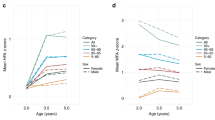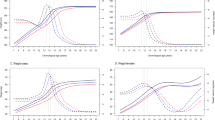Abstract
Objective:
To compare different approaches (visual estimation of individual BMI curves with polynomial models) to estimate age at adiposity rebound (AR), as different approaches might lead to different results. AR has been suggested as a critical period between intra-uterine life and early adulthood, and recent data showed that early age at AR is associated with higher body mass later in life.
Methods:
Longitudinal anthropometric data from the DOrtmund Nutritional and Anthropometric Longitudinally Designed (DONALD) Study were used to obtain individual BMI growth curves. We then compared the visual estimation approach to polynomial models in three different scenarios reflected by different data sets: an idealistic, an realistic, and a realistic scenario with imputed values.
Results:
In all three scenarios, the visual estimation yielded significantly higher estimates than the polynomial models of 2nd or 3rd order. Cross-tabulations of groups of age at AR (early, medium, and late) showed that truly concordant classification was low, ranging only from 51 to 63%. A closer examination of the data indicated that the differences in estimates were mainly due to differences in the underlying definitions: the polynomial models select the nadir in the growth curve as the age at AR, whereas the visual estimation deviates from this concept in those cases where there is plateau in the growth curve. In the latter instance, the turning point of the growth curve before its increase is selected as the age at rebound.
Conclusions:
Estimating AR with the visual approach appears to best reflect the physiological basis of the AR, and is also preferable, because it resulted in the lowest number of children with missing estimates for age at AR.
Only when the underlying criteria for the estimation of AR with the visual approach were modified, could concordant results between the two approaches be obtained. Considering the underlying physiological basis, it became clear that approaches which determine AR by simply identifying the nadir in the BMI curve do not reflect AR appropriately. This refers to those cases in which the nadir in the growth curve and the turning point at the onset of the adiposity increase are not identical.
This is a preview of subscription content, access via your institution
Access options
Subscribe to this journal
Receive 12 print issues and online access
$259.00 per year
only $21.58 per issue
Buy this article
- Purchase on Springer Link
- Instant access to full article PDF
Prices may be subject to local taxes which are calculated during checkout

Similar content being viewed by others
References
Lobstein T, Baur L, Uauy R . Obesity in children and young people: a crisis in public health. Obes Rev 2004; 5 (Suppl 1): 4–104.
Bellizzi MC, Dietz WH . Workshop on childhood obesity: summary of the discussion. Am J Clin Nutr 1999; 70: 173S–175S.
Dietz WH . Periods of risk in childhood for the development of adult obesity – what do we need to learn? J Nutr 1997; 127: S1884–S1886.
Cameron N, Demerath EW . Critical periods in human growth and their relationship to diseases of aging. Yearbook Phys Anthropol 2002; 45: 159–184.
Rolland-Cachera MF, Deheeger M, Guilloud-Bataille M, Avons P, Patois E, Sempe M . Tracking the development of adiposity from one month of age to adulthood. Ann Hum Biol 1987; 14: 219–229.
Whitaker RC, Pepe MS, Wright JA, Seidel KD, Dietz WH . Early adiposity rebound and the risk of adult obesity. Pediatrics 1998; 101: E5.
Rolland-Cachera MF, Deheeger M, Bellisle F . The adiposity rebound: its contribution to obesity in children and adults. In: Chen C, Dietz WH (eds). Obesity in childhood and adolescence. Nestlé nutrition workshop series, pediatric program Vol 49. Philadelphia: Lippincott Williams & Wilkins, 2002. pp. 99–117.
He Q, Karlberg J . Probability of adult overweight and risk change during the BMI rebound period. Obes Res 2002; 10: 135–140.
Prokopec M, Bellisle F . Adiposity in Czech children followed from 1 month of age to adulthood: analysis of individual BMI patterns. Ann Hum Biol 1993; 20: 517–525.
Wisemandle W, Maynard LM, Guo SS, Siervogel RM . Childhood weight, stature, and body mass index among never overweight, early-onset overweight, and late-onset overweight groups. Pediatrics 2000; 106: E14.
Rolland-Cachera MF, Deheeger M, Bellisle F, Sempe M, Guilloud-Bataille M, Patois E . Adiposity rebound in children: a simple indicator for predicting obesity. Am J Clin Nutr 1984; 39: 129–135.
Dorosty AR, Emmett PM, Cowin S, Reilly JJ . Factors associated with early adiposity rebound. ALSPAC Study Team. Pediatrics 2000; 105: 1115–1118.
Siervogel RM, Roche AF, Guo SM, Mukherjee D, Chumlea WC . Patterns of change in weight/stature2 from 2 to 18 years: findings from long-term serial data for children in the Fels longitudinal growth study. Int J Obes 1991; 15: 479–485.
Kroke A, Manz F, Kersting M, Remer T, Sichert-Hellert W, Alexy U et al. The DONALD Study. History, current status and future perspectives. Eur J Nutr 2004; 43: 45–54.
Kersting M, Alexy U, Kroke A, Lentze MJ . Nutrition of children and adolescents. Results of the DONALD Study. Bundesgesundheitsblatt Gesundheitsforschung Gesundheitsschutz 2004; 47: 213–218.
Buyken AE, Hahn S, Kroke A . Differences between recumbent length and stature measurement in groups of 2- and 3-y-old children and its relevance for the use of European body mass index references. Int J Obes Relat Metab Disord 2005; 29: 24–28.
Guo SS, Huang C, Maynard LM, Demerath E, Towne B, Chumlea WC et al. Body mass index during childhood, adolescence and young adulthood in relation to adult overweight and adiposity: the Fels Longitudinal Study. Int J Obes Relat Metab Disord 2000; 24: 1628–1635.
Freedman DS, Kettel Khan L, Serdula MK, Srinivasan SR, Berenson GS . BMI rebound, childhood height and obesity among adults: the Bogalusa Heart Study. Int J Obes Relat Metab Disord 2001; 25: 543–549.
Eriksson JG, Forsen T, Tuomilehto J, Osmond C, Barker DJ . Early adiposity rebound in childhood and risk of Type 2 diabetes in adult life. Diabetologia 2003; 46: 190–194.
Knittle JL, Timmers K, Ginsberg-Fellner F, Brown RE, Katz DP . The growth of adipose tissue in children and adolescents. J Clin Invest 1979; 63: 239–246.
Author information
Authors and Affiliations
Corresponding author
Rights and permissions
About this article
Cite this article
Kroke, A., Hahn, S., Buyken, A. et al. A comparative evaluation of two different approaches to estimating age at adiposity rebound. Int J Obes 30, 261–266 (2006). https://doi.org/10.1038/sj.ijo.0803143
Received:
Revised:
Accepted:
Published:
Issue Date:
DOI: https://doi.org/10.1038/sj.ijo.0803143
Keywords
This article is cited by
-
Longitudinal association between the timing of adiposity peak and rebound and overweight at seven years of age
BMC Pediatrics (2022)
-
Age at adiposity rebound and the relevance for obesity: a systematic review and meta-analysis
International Journal of Obesity (2022)
-
Associations of grandparental diabetes mellitus with grandchild BMI status
BMC Public Health (2019)
-
Earlier BMI rebound and lower pre-rebound BMI as risk of obesity among Japanese preschool children
International Journal of Obesity (2018)
-
Potential selection effects when estimating associations between the infancy peak or adiposity rebound and later body mass index in children
International Journal of Obesity (2017)



